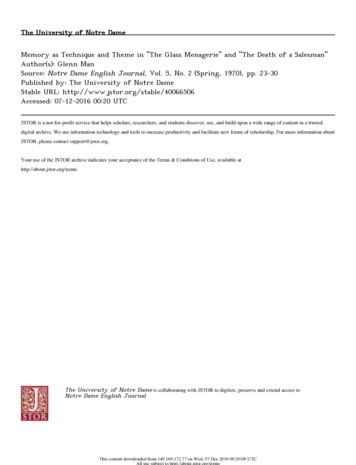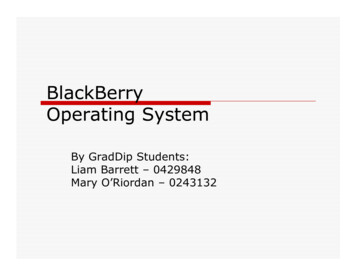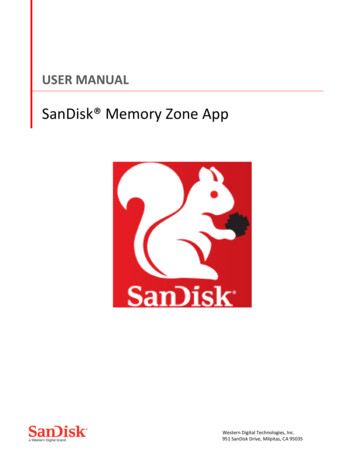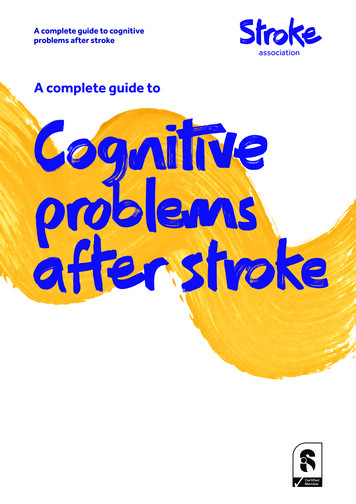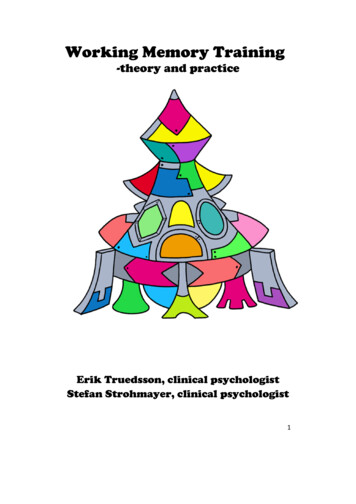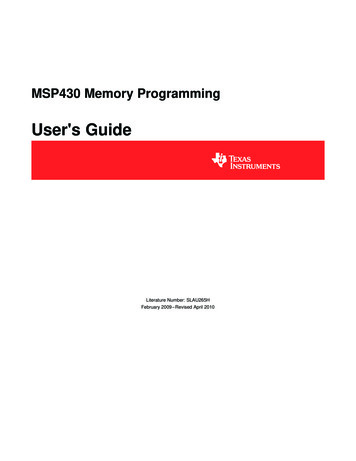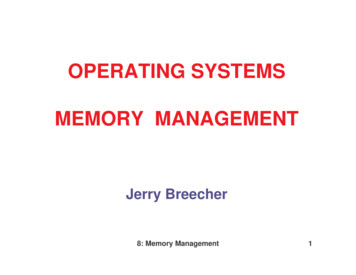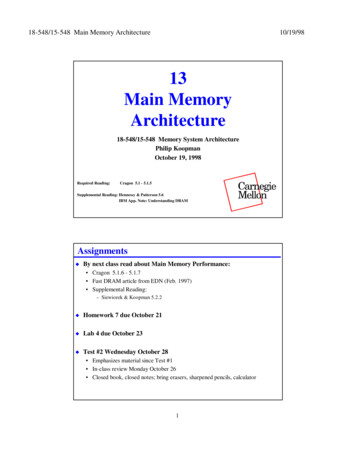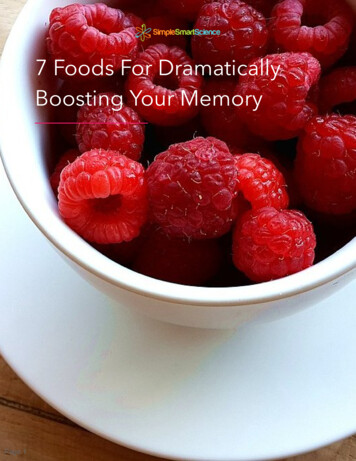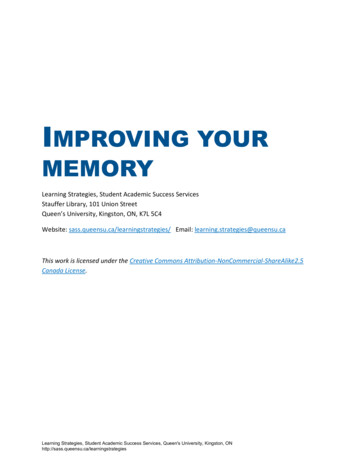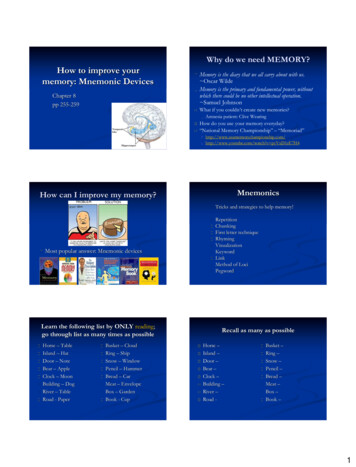
Transcription
Why do we need MEMORY?How to improve yourmemory: Mnemonic DevicesChapter 8pp 255-259Memory is the diary that we all carry about with us. Oscar WildeMemory is the primary and fundamental power, withoutwhich there could be no other intellectual operation. Samuel JohnsonWhat if you couldn’t create new memories?Amnesia patient: Clive WearingHow do you use your memory everyday?“National Memory Championship” – /http://www.youtube.com/watch?v pyVxD1zE7H4MnemonicsHow can I improve my memory?Tricks and strategies to help memory!Most popular answer: Mnemonic devicesLearn the following list by ONLY reading;go through list as many times as possibleHorse – TableIsland – HatDoor – NoteBear – AppleClock – MoonBuilding – DogRiver – TableRoad - PaperBasket – CloudRing – ShipSnow – WindowPencil – HammerBread – CarMeat – EnvelopeBox – GardenBook - CupRepetitionChunkingFirst letter techniqueRhymingVisualizationKeywordLinkMethod of LociPegwordRecall as many as possibleHorse –Island –Door –Bear –Clock –Building –River –Road -Basket –Ring –Snow –Pencil –Bread –Meat –Box –Book –1
Repetition techniqueAnswersHorse – TableIsland – HatDoor – NoteBear – AppleClock – MoonBuilding – DogRiver – TableRoad - PaperBasket – CloudRing – ShipSnow – WindowPencil – HammerBread – CarMeat – EnvelopeBox – GardenBook - CupChunkingShort-term memory capacity limitMagic number 7 /- 2Memory spanRemember: 7 0 4 8 6 4 2 3 2 1 8 9Or remember: 704 864 23 21 89Remember 7 /- 2 CHUNKSWhy helpful?Increase capacity by grouping informationGives meaning to random informationRhyming techniqueWhen did Columbus discover America?“In fourteen hundred ninety-two, Columbus sailedthe ocean blue”“i before e except after c; or when sounded likea, as in neighbor and weigh”“Thirty days has September, April, June, andNovember”ABC’s song (rhyming and chunking)Why helpful?RepetitionForces you to pay attentionVisual and verbal memory for materialSpacing effectDistributed practice is best for delayed testMassed practice ok for immediate testWhy?Time to consolidate infoOnly concentrate for so longStudy under different conditions/settingsFirst-letter techniqueAcronym:ROY G BIV: colors of the rainbowHOMES: great lakesPRICE: InjuryAcrostic: first letter of each word of sentence is cueMusic notes: Every Good Boy Deserves Fun12 cranial nerves: OOO To Touch And Feel Why helpful?Letters act as cueChunkingDual-coding hypothesisDual-coding2 cues: verbal and visualVisualization“HOMES”Picture superiority effectEffective visualizationInteractionVividnessBizzareness2
Learn the following list by creating a mentalimage of two items in vivid interactionBird – FruitRain – RockDress – MoneyHouse – MountainCow – FlowerCorn – GateRoof – NestBaby – HairIce – TrainFence – LetterEgg – ChairBook – WaterCoat – GlassCandy – SignRabbit – PaintHammer - BookRecallBird –Rain –Dress –House –Cow –Corn –Roof –Baby –Keyword mnemonicAnswersBird – FruitRain – RockDress – MoneyHouse – MountainCow – FlowerCorn – GateRoof – NestBaby – HairIce –Fence –Egg –Book –Coat –Candy –Rabbit –Hammer -Ice – TrainFence – LetterEgg – ChairBook – WaterCoat – GlassCandy – SignRabbit – PaintHammer - BookImage–name mnemonicUse to learn foreign language vocabularySpanish example: Pato DuckFirst step:Concrete keyword that sounds like foreign word PotSecond step:Form visual image connecting keyword with meaningPicture: Duck wearing a pot on its headUse for any vocabulary wordsTry: “Skulk”: To hide or sneak around for evil reasons”Link mnemonicChaining or Link systemUse to remember name with faceThink of vivid word that sounds like nameLink word with person’s appearanceExampleRodney FlaneryImage: Football player with rod in his knee, sobenched and wearing flannel to stay warmCreate one for your own name!First: form visual image for each itemSecond: associate image with next imageImportant to SEE associationsNarrative techniqueForm a story using items you want to rememberAppropriate for serial learningProblem: if forget one item then next items may beinaccessible too3
Method of LociMethod of Loci: Campus Map“In the first place”1. Memorize familiar locations in natural order2. Create visual image of word with eachlocation3. Recall: take a “mental walk”Begin to write only after I have given the signal, “Go”.Olin, DuPre, Main, Snyder, Library, Carlisle, Daniel, Milliken, rflyScissorsPeg-word techniqueFirst: use memorized concretenounsRhyming words with numbershelps to remember wordsSecond: create visual image oftarget word with peg-wordSimilar to Loci: objects instead oflocationsProblem: limited # peg-wordsMethod of Loci: rflyScissorsLocations serve as a cueHelpful for serial learningLocations should be distinctNeed strong association betweenlocation and itemProblem: using same locationsover again can lead to confusionThought paperWhat tricks and strategies do you use tomemorize information?You go to a party and meet lots of new people.You would like to be able to remember theirface and name. How do you do it?4
Thought paper continued Why mnemonics workAttentionEnsure encodingWhy do these techniques work to improvememory? What do they share in common?RepetitionRetrieval cuesDual-coding cuesWhich of these techniques could you realisticallyuse to help you study for exams?Why wouldn’t you use some of them?OrganizationVerbal and visual representations“chunks”Notice relationships and differencesUse existing knowledgeElaborationThink about meaning and make distinctiveGenerationYour ideas makes it personalLimitations of MnemonicsTimeHow to deal with abstract material?Learning vs. retentionCreative abilityInterferenceDoesn’t help memory in generalDoes not help understanding of materialNeed to practice mnemonics!5
How to improve your memory: Mnemonic Devices Chapter 8 pp 255-259 Why do we need MEMORY? Memory is the diary that we all carry about with us. Oscar Wilde Memory is the primary and fundamental power, without which there could be no other intellectual operation
